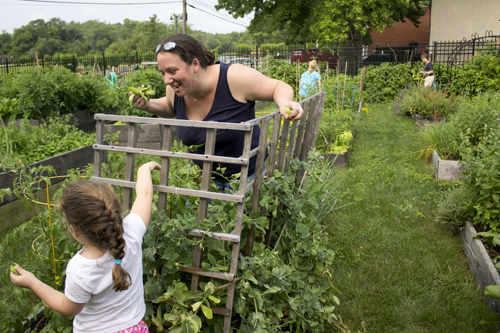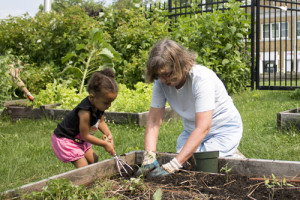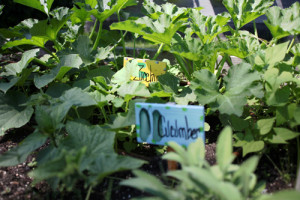Community garden is still a ‘magic’ space downtown

“Mom! Mom! I love this garden!”
That’s what six-year-old Summer Realander shouts to her mother, Kristen Realander, across the River and Roots Community Garden on a sunny Wednesday morning.
If you walk down this stretch of Main Street, there’s a chance you might hear the tinny ring of children’s laughter coming from the garden. And while watching them in action, it’s easy to see why: the kids love gardening.
“As long as there’s something here for [my children] to pick, they’re thrilled,” Ms. Realander said.
The garden is in its fifth summer of use after opening in 2011 thanks to a portion of a $1.2 million grant from the Cornell Cooperative Extension. Despite obstacles along the way — including Hurricane Sandy — the garden is set to continue with support from the community even after that funding runs out in October. Lots currently go for $25 per year for each bed, and organizers have no plans to increase the cost.

Each of its 36 beds belongs to a local individual or family. Most tend to their crops two or three times per week by weeding and trimming, and thanks to an irrigation system, they don’t have to worry about watering every day.
Stacey Stephenson has been using her bed since the garden opened up, and she said she is using it as a tool to educate her daughter Leila.
“It really gives the kids a sense of community,” she said. “We had our bed before our daughter was born, so we plan on keeping it until they’re older. We think it keeps them grounded.”
Many of the users said they have found a sense of community through their close work with other gardeners.
“I’ve met a whole bunch of special people working here that I never would have met before,” said Lee Van Vliet, who has been with the garden since its first year. “So it’s just as social as it is an opportunity to grow.”
Jenny Intravia, who has also had a bed since the garden’s opening, was put on bedrest while pregnant with her second child. But rather than let her plants fade away, her fellow gardeners maintained her bed until she could return.
“This place has been a haven for myself and my family,” she said. “When I come in here, it’s like magic.”

Co-founders Amy Davidson and Laurie Nigro organize regular potluck dinners — including one every year to watch fireworks in the garden on Independence Day weekend — and educational seminars on horticulture.
“It’s really been a community garden in the true definition of it,” Ms. Nigro said. “We have all ages, all genders. We had hoped for it to be representative of the community, and I like to think that it is.”
Some years, prospective gardeners have been put on a waiting list due to demand, but this year, a single box remains free.
Though the garden is fenced off, users and organizers said it helps those outside its borders as well. Its construction in 2011 converted a vacant lot next to the laundromat into a verdant patch overlooking the Peconic River.
“I just think it’s a wonderful idea to take a spot that nothing was being done with and turn it into this great creative adventure,” said Jo Anne Tate, who just joined the garden last month.
Sprawling raspberry bushes poke through the fence onto the sidewalk outside — and passersby are welcome to eat those berries.
Susan Wilk, project coordinator for the Cornell Cooperative Extension, said that River and Roots motivated the town to build a playground right next door.
“This garden was the Main Street catalyst for change,” she said.
Ms. Wilk also said that about 25 percent of the produce grown is donated to local charities and church groups.
In the garden, you can find colors all across the spectrum: bright orange butternut squashes, deep red tomatoes, delicate violet flowers and, of course, lots and lots of greenery.
Ms. Nigro recalled that in one year, the garden yielded about 600 pounds of produce. Tomatoes are the most popular — each bed has at least one tomato plant, she said — though zucchini are the most abundant.
In the middle of an interview, she pointed at Leila Stephenson carrying peas to her mother.
“This is why we do this,” she said.







